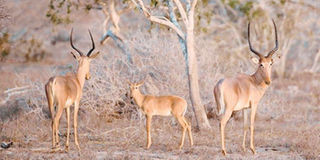A sanctuary for the hirola

In 1996, there were 15,000 hirola but now only a few hundred are left.
What you need to know:
- Ishaqbini’s translation, ‘mosquito swamp’, belies the wealth of wildlife found in this conservancy beside the Tana River
Comfortably ensconced in Garsen, we look at the map for areas to explore and Ishaqbini comes into sight. Ishaqbini is derived from the Orma words ishaq for wetland and bini for mosquitoes, which translates into a mosquito swamp.
I first heard of it was when Ian Craig of the Northern Rangelands Trust (NRT) told me it was the latest ‘kid on the block’ – the community had asked if it could join NRT, which is taking a lead in establishing community conservancies.
Sitting at the office in Lewa Downs in Laikipia, Ishaqbini on the banks of the Tana River seemed far flung. But from Garsen, it is an opportunity I can’t waste.
Rare species
After driving for two hours through remote dry scrub without any water in sight, we reach the village of Kotile.
Being the month of Ramadhan, everyone is resting indoors and there is pin-drop silence. We chance upon a young man who shows us the way to the conservancy. This far-flung village of a few homesteads rarely sees visitors.
Twenty minutes later, we’re at a smart white-washed gate of the conservancy and the NRT offices. A polished brass plaque says that the conservancy was opened by then Tourism minister Najib Balala on May 20, 2011.
Mohamed Ismail, the young officer in charge of the conservancy’s security, welcomes us to the office, where photographs of the animals in the conservancy are pinned on the board… leopard, cheetah, elephants, and – my heart skips a beat – the hirola and the African wild dog.
Maybe today is the day I’ll see the two animal species I have never seen despite visiting all the prime spots where they’re found. This cat-and-mouse-game has become very challenging.
“We have 120 hirola in the conservancy. Along with those in Arawale (the first conservancy established for the protection of the endangered hirola antelope only found in this region in the world), there are 300,” Ismail informs us.
‘Arawale’ is the Somali word for the hirola.
The conservancy is owned by three communities – the Korissa, Hara and Kotile. Using the participatory integrated community approach, the conservancy has employed 20 community scouts to patrol the conservancy 24 hours a day and a team of managers and labourers also from the community to build the infrastructure.
Trapping predators
“The pastoral community has an area set aside for wildlife where no livestock grazing is allowed. In 2007, Ian Craig met with the communities at a baraza and showed them how to establish the conservancy.
We own it and have a board of 15 members that consists of five members from each of the three communities,” our guide explains.
Upon entering the conservancy, our first stop is at the hirola sanctuary, a predator-proof refuge protected by a brand new wire fence with bright yellow streamers so that the hirolas can see the barrier and hence avoid injury.
“In 1996, we had 15,000 hirola around here but most were killed by predators,” Ismail says.
The next stage, with the assistance of the NRT, is to get the hirola inside the sanctuary and all the predators, such as hyenas, outside.
The 30-square-kilometer sanctuary for the hirola is interesting. It has two gates. One gate is open to allow the predators in, lured with meat. Their only escape is when the other gate is opened to allow them out.
The refuge is beside the workshop so that any repairs are carried out immediately.
“The poles are made from the Terminalia spinosa, a hardwood that can last 500 years without being destroyed by termites,” Ismail continues.
The game drive gets more intense and we spot the first antelope. Could it be the hirola? No, it’s a waterbuck – disappointing. In the dryland scrub, we see a flock of vulturine guinea-fowl of almost 1,000 – the largest I’ve seen – reticulated giraffes, zebra, topi, kudu, warthogs… but two hours later, no African wild dog or hirola.
“It’s too short a time,” Ismail consoles me. “You have to come back because we are building a lodge and you can stay longer.”
Ah well, I guess it will have to be.




